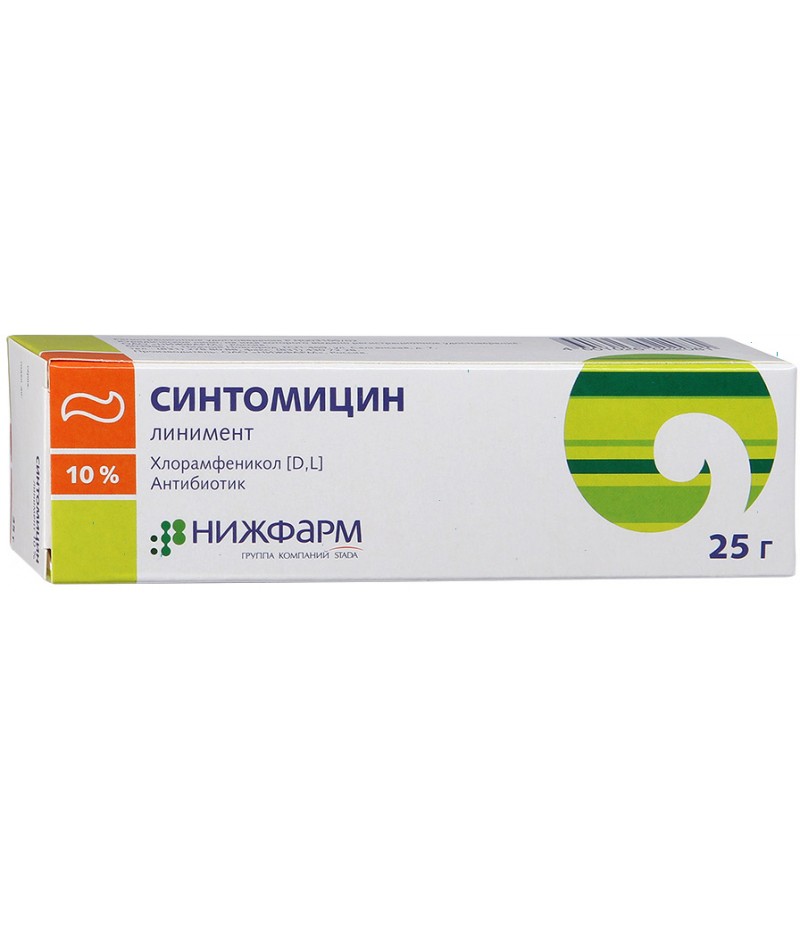Liniment Synthomycin 10% 25gr
- $6.93
- 3 or more $6.50
- Availability:In Stock
Synthomycin instruction for useYou can buy Synthomycin on this pageCompositionThe 10% liniment of Synthomycin is: D, L-chloramphenicol, emulsifier, preservative, castor oil, purified water and sodium carboxymethylcellulose.Form of..
Synthomycin instruction for use
You can buy Synthomycin on this page
Composition
The 10% liniment of Synthomycin is: D, L-chloramphenicol, emulsifier, preservative, castor oil, purified water and sodium carboxymethylcellulose.
Form of issue
Issued by:
0.15% solution (10 ml);
1% Synthomycin liniment with novocaine in vials of 25, 50 and 100 g;
globulated vaginal for 10 pcs. packaged;
Ointment Synthomycin liniment 10%, 5%, 1% in cans of 10, 25, 50 and 100 g;
Candles Synthomycin for 4 and 10 pcs. packaged.
pharmachologic effect
Increased antibacterial activity in relation to various forms of purulent-inflammatory processes and pathogens of infections in wounds.
Pharmacodynamics and pharmacokinetics
This agent is a bacteriostatic antibiotic with a broad spectrum of action. It is able to disrupt protein synthesis in a microbial cell, and also promotes the rapid disinfection and healing of trophic ulcers and burn wounds. It is active in relation to most strains of harmful microorganisms, including those that can not be affected by penicillin, sulfonamide and tetracycline. However, the degree of systemic exposure to skin after use of this drug has not yet been studied.
Indications for use
The emulsion is used:
for the treatment of purulent wounds;
from acne;
with the purpose of healing burns of 2-3 degrees and trophic ulcers;
against purulent-inflammatory diseases of the skin.
Candles with Synthomycin in gynecology are used in the presence of spirochaetes and rickettsias, as well as against intestinal, meningococcal and purulent infections.
Contraindications
This tool is not used when:
individual intolerance;
acute intermittent porphyria;
hepatic and renal insufficiency;
pregnancy;
age of up to 4 weeks (candles are not used until puberty);
oppression of bone marrow hematopoiesis;
lack of glucose-6-phosphate dehydrogenase;
skin diseases;
lactation.
Side effects
When applying the ointment, there may be an allergic reaction: skin rashes, angioedema. In rare cases, there is reticulocytopenia, granulocytopenia, erythropenia, agranulocytosis, leukopenia, thrombocytopenia, aplastic anemia. In turn, candles can candidiasis genital organs.
In case of side effects, immediately consult a doctor.
Instructions for use on liniment Synthomycin
In the instructions for the use of the Synthycin ointment, it is reported that it is suitable strictly for external use. It is intended for topical application in the affected area. Instruction for liniment Synthomycin indicates that the emulsion is applied first, and then a bandage of waterproof material is applied on it, which is changed every 2-4 days prior to healing.
Candles are injected into the vagina, while the patient is lying on her back. The general course of treatment is designed for 7-10 days.
Overdose
Cases of overdose when using this tool are not known.
Interaction
If you use Synthomycin together with erythromycin, lincomycin and clindamycin, this can lead to mutual weakening of the drugs. In addition, this drug weakens the decontaminating effect of penicillins and cephalosporins.
Terms of sale
This drug is dispensed in pharmacies without a prescription.
Storage conditions
Store the emulsion in a dry, protected from light and cool place.
Shelf life
If the storage conditions are met, the drug can be used for 2 years.
Reviews of Synthomycin
Reviews of Synthomycin are usually positive. Those who have already tried this tool on themselves, note that to get rid of skin problems and various inflammations it helps literally in a matter of days.
Liniment from acne, according to reviews, is used especially often. Many argue that this is almost the best remedy for people with problem skin.

